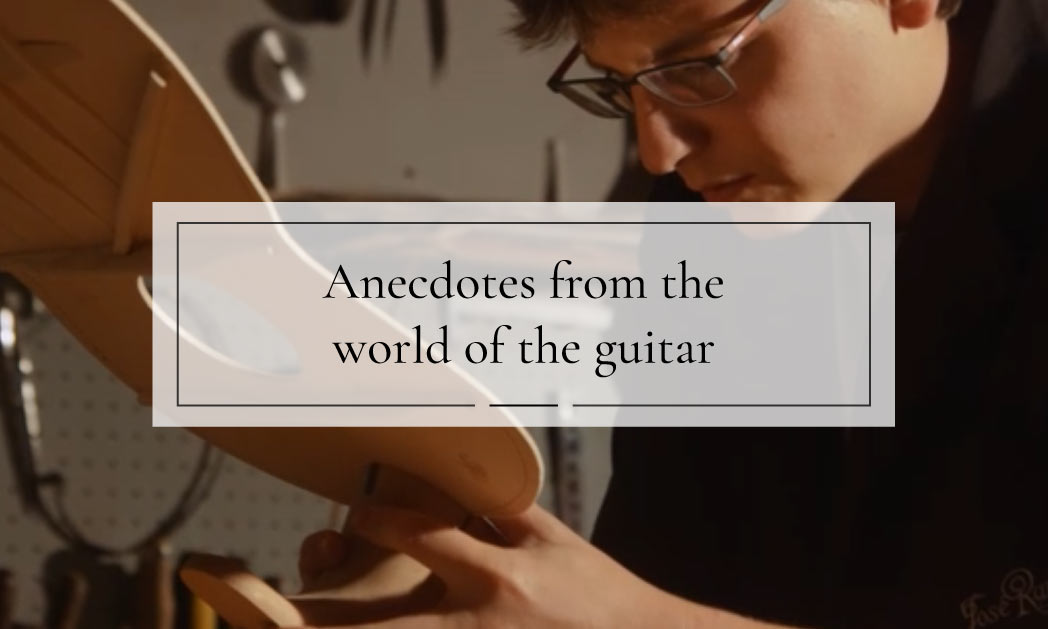Here we have some funny anecdotes related to the guitar. To have some fun. With no other hope. It is only an invitation to have a nice time.
This is a sale
For those who didn’t know the shop in Concepción Jerónima 2, I will describe it briefly. It was a two-story building. The shop was downstairs, it was a long room, the office was at the end of it – at my grandfather’s and father’s time, such as I knew it – and the workshop was upstairs.
The guitarists that came to test guitars would sit on some chairs that were in front of the counter, next to the wall that hid the stairs that took to the workshop. When the workshop closed, the skilled workers and apprentices would walk down the shop and pass between the counter and the chairs to leave the shop.
I was told an anecdote about a gipsy man that was trying a guitar in one of the chairs of the shop. When it was time to close the workshop and the workers began to go down, the gipsy man looked at them as they were passing by almost in front of him. In the beginning, nothing happened, but as they were showing up, he started to get a bit tense.
One of these skilled workers was a lame person, and the woman in charge of the varnish, who was not very young, was one-eyed. They said goodbye to those who were in the shop and walked to the door… and the gipsy man, watching them go by one behind the other, woke up overwhelmed, put the guitar on the counter and before going away through the door exclaimed: “Gosh, thiz iz a zale!” and he left never to come back.
Perico de los Palotes (Mr. Anyone)
That happened to me about eight or nine years ago (I’m writing in 2012). I received an e-mail from an upset man because he had seen a letter from Andrés Segovia to my father, which we had published in his book “Things about the Guitar”, to his disappointment he had discovered that the signature had been forged.
Before going on, I must say that Andrés Segovia wrote a letter to my father, in its last paragraph it said: “In his tenacious pursuit to realize his life’s ideal, José Ramírez, I’m sure he will be able to build the most sonorous and beautifully timbered guitars in the whole world”. But some time after that, in one of the visits my father paid to his studio in Concha Espina Street, Segovia asked him to take this letter because he had to do a rectification. When he was given the new letter, in the last paragraph he had written what follows: “In his tenacious pursuit to realize his life’s ideal, José Ramírez has built the most sonorous and beautifully timbered guitars in the whole world”.
Well, so we had the two letters framed –they were identical in everything but the last paragraph– at that moment the only thing that was done was to swap the old one with the new one and leave it this way. But when the shop was moved from Concepción Jerónima to La Paz Street, apparently, as we didn’t pay enough attention, we hung the old one, whereas in the book Things about the Guitar it was the, let’s say, good one, corrected by Segovia.
On top of everything else, it seems that, although the editor of my father’s book had published the good letter, I don’t remember the reason why he did a copy/paste in an old-fashioned way (that is, a copy/ cut/paste as you can) of Andrés Segovia’s signature, so the sticky mess could be clearly seen. As I realized that, I told him that he had to change it, not only because it looked like a forge, but it was also crude and ugly.
To avoid destroying the whole edition, the editor decided to print an extra page with the original letter and signature, not patching it up, and he added it on the botched page on which, moreover, he stamped several times the editorial’s stamp to hide the signature of the cut/ paste; as it can be seen a very subtle way of concealing facts, so if someone decided to remove the superimposed page (a temptation impossible to resist, I think), the super-corrected, crossed out and sticky signature of Segovia could be found.
To avoid entering tricky fields that have nothing to do with the topic we are dealing with, let’s leave it, simplifying, that we accept the patch-up job. It is also convenient to clarify, before going on, that this only happened in the first edition, as in the following ones this affair was definitely and adequately corrected.
The gentleman that wrote me indignantly –and let’s admit it, quite right– had apparently read the book, he had seen the patch-up job of Segovia’s signature in a letter that said that Ramírez had built the most sonorous and beautifully timbered guitars in the whole world, and after that, he had gone to the shop and he had read the old letter we had hanged there that said that the truth was that Ramírez would be able to build the most sonorous guitars and so on, and, obviously he reached to the inevitable conclusion that we had forged everything.
Once he exposed his disappointment with a wealth of detail, he said goodbye signing as Perico de los Palotes (Mr. Anyone).
Soon afterwards, I phoned the shop and talked to the manager, and I asked him to check the content of Segovia’s letter we had hung in the shop. Indeed, that was the “bad” letter. Now we had to look for the “good” one and substitute it immediately. He searched, found it and substituted it.
Then, in no time, I answered the e-mail more or less this way: “Dear Mr. Anyone, you are completely right. It seems that, after we moved from Concepción Jerónima to La Paz Street, we hung up the first of the letters Andrés Segovia wrote to my father, as it didn’t occur to us to read the letter before hanging it on the wall. Thanks to your e-mail we’ve been able to detect the mistake and substitute the first letter with the one corrected afterwards by Segovia that was given to my father by him. You can come to the shop whenever you want and check it is not a forge”.
I phoned the shop manager and I asked him to pay attention to everything that took place around the letter. After a while he phoned me to tell me that about half an hour later, a guitar teacher he knew entered the shop, walked to the frame in the wall where we had the letter, was having a look for a while and he left.
I had the temptation to ask him who he was, but I preferred to respect his desire for privacy and the enchanted mystery hidden behind the name Mr. Anyone. This way I have no idea who he was, but I’m really grateful that he detected such a great mistake, allowing me to correct it appropriately. As usual, everything happens for a good reason.
Mr. Juan Baello and lust
I think this is the correct spelling: Baello, but I’m not sure, as this is a funny anecdote that a friend told me and she wasn’t sure either if it was written with a V or a B.
So we will leave it as Mr. Juan Baello, this way, as it sounds.
This story has nothing to do with the Ramírez House in particular, but it has to do will all Spanish guitars of the world. And I found it so funny that I thought it deserved a place in this brief collection of anecdotes.
I am going to write in the first person, as my friend told me.
“I was about four or five years old. I was in Angelines’ house; she was my brother’s godmother. She was a very religious woman (from Catholic Action) and the image of the Sacred Heart was periodically taken to her house, and sometimes the Miraculous Virgin, and during the week she had these images in her house some friends, faithful and devoted people used to go to pray to them.
One of the times when my grandmother took me, a man appeared, he was highly respected by everyone as he belonged to the Night Adoration, and in my four-year-old image, I remember him as a very tall man, wrapped up in a Spanish cloak: Mr Juan Baello.
On this occasion, I was playing and suddenly Spanish guitar music sounded on the radio. The man stood up his chair and said outraged to Angelines (he lisped a bit): ‘thiz muzic zould be forbidden, becauze it inzites people to lust. Guitarz, with itz zhapes that remind the zhapes of women are zinful, and thiz muzic inzites lust and it zould be forbidden on the radio’.
He savoured in such a way the word ‘lust’ that young as I was; it seemed to me something really desirable as he pronounced ‘lust’ as if he was savouring chocolate that melted in his mouth. It was something strange and fascinating. I remember this conversation due to the pleasure with which he savoured the word ‘lust’. A lot of years later I learned the meaning of the word ‘lust’ and it seemed to me even more fascinating”.
All these events took place in Ferrol, at the beginning of the sixties. And although I know the association of the guitar with the body of a woman is not original at all, I do think the emotional intensity that the guitar awakens in this man is really curious, that’s why I think it’s worth mentioning it.
The truth is that I know several wives of guitarists jealous of the relationship of their beloved with guitars. In fact, one of them even told me that watching the way her husband would hold the guitars, look at them and play them, she would feel jealous. We will leave it here so that everyone reaches their own conclusions that, by the way, don’t have to be shared; but it would be funny to take this opportunity to invite the readers to tell us their own experiences on the matter, of course anonymously, as Mr. Anyone did.


